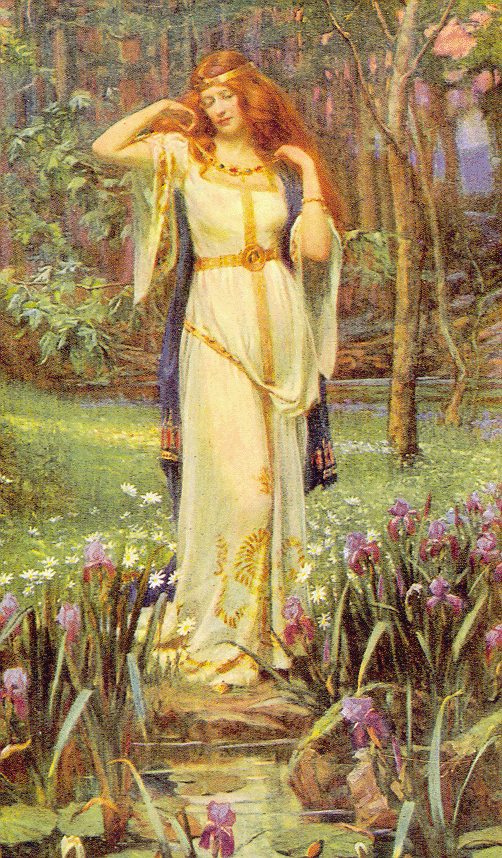The Valkyrie
Hi dear friends and followers welcome to my blog.
Time for a little change on this blog. Today's offering is from Norse mythology and it concerns an intimate part of a Norseman's life: being valiant in battle and the reward for valor conferred by a Valkyrie. If you have no idea what a Valkyrie is or what it might do, please read on. If you do already know, this article might shed a new light upon your knowledge. I hope that you enjoy it.
The Valkyrie is, in the oldest strata of belief, a corpse goddess, represented by the carrion-eating raven. The name in Old Norse, valkyrja, means literally, "chooser of the slain." The Valkyrie is related to the Celtic warrior-goddess, the Morrigan, who likewise may assume the form of the raven.
Midway between the third and eleventh centuries, the Valkyries begin assuming a more benign aspect. Small amulets and pictures on memorial stones begin to depict the figure of the beautiful woman welcoming the deceased hero with a horn of mead to the afterlife. Valkyries are usually represented as blonde, blue eyed and fair skinned. They wear scarlet corselets and carry shields and spears.
Midway between the third and eleventh centuries, the Valkyries begin assuming a more benign aspect. Small amulets and pictures on memorial stones begin to depict the figure of the beautiful woman welcoming the deceased hero with a horn of mead to the afterlife. Valkyries are usually represented as blonde, blue eyed and fair skinned. They wear scarlet corselets and carry shields and spears.
By this later time, the Valkyries, as demigoddesses of death, had their legend conflated with the folklore motif of the swan maidens (young girls who are able to take on the form of a swan, sometimes as the result of a curse). If one could capture and hold a swan maiden, or her feathered cloak, one could extract a wish from her. This is why valkyries were sometimes known as swan maidens or wish maidens.
Although the sources consulted are not clear on this, the chief of the Valkyries seems to have been the goddess Freyja. She is the Norse goddess of love, fertility, and beauty, sometimes identified as the goddess of battle and death. Blond, blue-eyed, and beautiful, Freyja travels on a golden-bristled boar or in a chariot drawn by cats. She resides in the celestial realm of Folkvang. Like Odin, she received half of those slain in battle, but since ladies go first she was allowed first choice! Freyja possessed a magical cloak of falcon feathers that allowed her to take the shape of a falcon if she wished, making the swan maidens similar to the goddess by having "feather coats" or cloaks that enable their shape-shifting abilities and the power of flight.
The Valkyries carry out the will of Odin in determining the victors of the battle, and the course of the war. Their primary duty is to choose the bravest of those who have been slain, gathering the souls of dying heros or warriors found deserving of afterlife in Valhalla. They scout the battle ground in search of mortals worthy of the grand hall. If you are deemed by the Valkyries as un-worthy of the hall of Valhalla you will be received after death by the goddess Hel in a cheerless underground world.
There are several traditional names for Valkyries mentioned in the sagas and the Eddas:
Brynhildr ("Byrnie of Battle" or "Mail-coat of Battle")
Sigrdrifa ("Victory Blizzard")
Sigrún ("Victory Rune")
Sváva KáraHrist ("The Shaker")
Mist ("The Mist" or "The Fog")
Skeggjöld ("Wearing a War Axe")
Skögul ("Battle" or "Rager")
Hildr ("Battle")
Þrúðr ("Power")
Hlökk ("Noise", "Din of Battle")
Herfjötur ("War-Fetter")
Göll ("Loud Cry", "Battle Cry")
Geirahöd ("Spear of Battle")
Randgríðr ("Shield of Peace")
Ráðgri'ðr ("Counsel of Peace" or "Gods' Peace")
Reginleif ("Heritage of the Gods")
Gunnr ("Battle")
Róta ("She Who Causes Turmoil")
Skuld ("She Who Is Becoming")
Göndul ("Magic Wand" or "Enchanted Stave")
Friagabi ("Giver of Freedom")
The Valkyries are connected with the legend of the Raven Banner. This banner was woven of the cleanest and whitest silk and no picture of any figure was found upon it except in the case of war, at which time a raven always appeared upon it, as if woven into it.
If the Danes were going to win the upcoming battle, the raven appeared with his beak wide open, flapping its wings and restless on its feet.
If they were going to be defeated, the raven did not stir at all, and its limbs hung motionless.
Sometimes the blood-covered Valkyrie-prophetesses are seen themselves as weavers, to prophesy the outcome of the next day's battle.
The Valkyries are also Odin's messengers and when they ride forth on their errands, their armor causes the strange flickering light that is called the "Aurora Borealis" (Northern Lights).
Depending on who you talk to, the number of Valkyries varies from three to sixteen.
Any maiden who becomes a valkyrie will remain immortal and invulnerable as long as they obey the gods and remain virginal.
It is often said that if you see a Valkyrie before a battle, you will die in that battle.
The Valkyries appeared riding in a troop, often of nine war-like women.









No comments:
Post a Comment